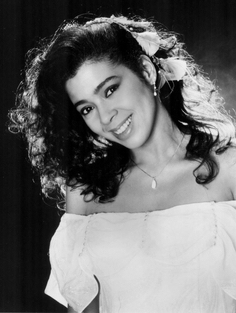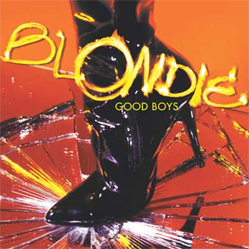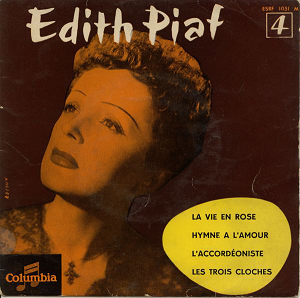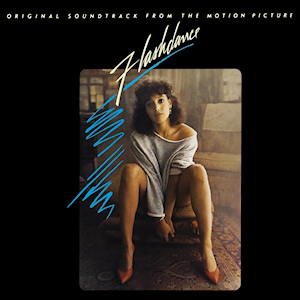
Irene Cara Escalera was an American singer and actress who rose to prominence for her role as Coco Hernandez in the 1980 musical film Fame, and for recording the film's title song "Fame", which reached No. 1 in several countries. In 1983, Cara co-wrote and sang the song "Flashdance... What a Feeling", for which she shared an Academy Award for Best Original Song and won a Grammy Award for Best Female Pop Vocal Performance in 1984.

"The Best Things in Life Are Free" is a duet between American singers Luther Vandross and Janet Jackson, recorded for the Jimmy Jam and Terry Lewis produced soundtrack to the 1992 American film Mo' Money, starring Damon Wayans. The song was composed by Jam, Lewis, Michael Bivins, Ronnie DeVoe, Harry Wayne Casey and Richard Finch. The song was released as the soundtrack's lead single on May 12, 1992, by Perspective Records and A&M Records. Additionally, the song was remixed by David Morales, Frankie Knuckles, and CJ Mackintosh. The duet became a major hit in several countries, peaking at number two in Australia and the United Kingdom, number six in Ireland and New Zealand, number eight in Canada and Germany, and number 10 in the United States. Its music video was directed by Paris Barclay, but didn't feature Vandross and Jackson. The song was nominated for the Grammy Award for Best R&B Performance by a Duo or Group with Vocals.

"Good Boys" is a song by American rock band Blondie. Issued on August 11, 2003, it was the only single released from their eighth studio album, The Curse of Blondie (2003). The single was released as part of a two-CD set and on 12-inch vinyl. CD 1 features live versions of "Maria" and "Rapture", plus the video for "Good Boys" directed by Jonas Åkerlund. CD 2 features a remix by Giorgio Moroder. The 12-inch vinyl features remixes by Giorgio Moroder, Arthur Baker, and Scissor Sisters.

"Flashdance... What a Feeling" is a song from the 1983 film Flashdance with music by Giorgio Moroder and lyrics by Keith Forsey and the song's performer, Irene Cara. Moroder had been asked to score the film, and Cara and Forsey wrote most of the lyrics after they were shown the last scene from it in which the main character dances at an audition for a group of judges. They felt that the dancer's ambition to succeed could act as a metaphor for achieving any dream a person has and wrote lyrics that described what it feels like when music inspires someone to dance. The song wound up being used for the scene they watched as well as during the opening credits as the main character is shown working as a welder.

"La Vie en rose" is the signature song of popular French singer Édith Piaf, written in 1945, popularized in 1946, and released as a single in 1947. The song became very popular in the United States in 1950, when seven versions reached the Billboard charts. These recordings were made by Tony Martin, Paul Weston, Bing Crosby, Ralph Flanagan, Victor Young, Dean Martin, and Louis Armstrong.

"Sidewalk Talk" is a song by American record producer John "Jellybean" Benitez from his first extended play, Wotupski!?! (1984). It was released on October 21, 1984, by EMI Records as the first single from the EP. The song was written by Madonna and produced by Benitez. They had initially met in 1983 and Benitez worked as a producer on Madonna's self-titled debut album. When he started work on his debut EP, Wotupski!?!, Madonna wrote "Sidewalk Talk" for him. The song features bass and electric guitars, synthesizers, piano, and drums. Lead vocals are by Catherine Buchanan with additional chorus vocals by Madonna.

"You Remind Me" is a song by American singer-songwriter Mary J. Blige. It served as Blige's first single from her debut album, What's the 411? (1992). Written by Eric Milteer and produced by Dave "Jam" Hall, it was originally used on the soundtrack of 1991 comedy film Strictly Business. The song marked Blige's first top forty hit, reaching number twenty-nine on the Billboard Hot 100 and number one on the Hot R&B Singles chart. The music video was released in 1992. The song also sampled Patrice Rushen’s 1982 song, ‘Remind Me’.

"On the Radio" is a song by American singer-songwriter Donna Summer, produced by Italian musician Giorgio Moroder, and released in late 1979 on the Casablanca record label. It was written for the soundtrack to the film Foxes and included on Summer's first international compilation album On the Radio: Greatest Hits Volumes I & II.

"Just Kickin' It" is a song by American R&B group Xscape. Written by Jermaine Dupri and Manuel Seal, the song was released in August 1993 by So So Def and Columbia as Xscape's first single from the group's debut album, Hummin' Comin' at 'Cha (1993). The single became the group's most commercially successful hit, peaking at number one on the US Cash Box Top 100, number two on the Billboard Hot 100, and spending four weeks at number one on the Hot R&B Singles chart.

"Domino Dancing" is a song by English synth-pop duo Pet Shop Boys, released in September 1988 by Parlophone as the lead single from their third studio album, Introspective (1988). The song reached number seven on the UK Singles Chart and topped the charts in Finland and Spain. Its music video was directed by Eric Watson and filmed in Puerto Rico.

"Electric Avenue" is a song by Guyanese-British musician Eddy Grant. Written and produced by Grant, it was released on his 1982 studio album Killer on the Rampage. In the United States, with the help of the MTV music video he made, it was one of the biggest hits of 1983. The song refers to Electric Avenue in London during the 1981 Brixton riot.

"Girlfriend" is a song by American singer Pebbles from her 1987 self-titled debut studio album. Written and produced by L.A. Reid and Babyface, "Girlfriend" was released as the album's lead single on October 26, 1987, by record label MCA. The song charted in several countries, peaking at number five on the US Billboard Hot 100 and reaching the top 10 in Ireland and the United Kingdom.

What a Feelin' is the second studio album by American singer-songwriter Irene Cara. Released on November 2, 1983, this album is a continuation of the work that Cara began with producer Giorgio Moroder on the soundtrack to the 1983 film Flashdance. The dance-pop song she co-wrote with Moroder and Keith Forsey for the film, "Flashdance... What a Feeling", went to number one on Billboard magazine's Hot 100 and foreshadowed the style of this album, which was unlike her R&B-heavy debut. Although Cara was more accustomed to composing music, she relinquished most of those duties to Moroder here and shifted much of her songwriting focus to lyrics.

Flashdance: Original Soundtrack from the Motion Picture is the soundtrack to the 1983 film Flashdance, which tells the story of Alex Owens, a welder and exotic dancer who dreams of becoming a professional ballerina. The nightclub performances by Alex and her co-workers and other set pieces involving training and auditioning provided opportunities to present the songs that would make up the soundtrack album. The film's music supervisor, Phil Ramone, made selections that he felt were the best fit for their respective scenes, and composer Giorgio Moroder contributed additional tracks in the process of scoring the film. One of his contributions, "Flashdance...What a Feeling" by Irene Cara, was released as a single in March 1983, weeks before the film's April 15 release, and eventually spent six weeks at number one on the Billboard Hot 100. The soundtrack was released on April 11, 1983 by Casablanca Records.

D.C. Cab: Music from the Original Motion Picture Soundtrack is the soundtrack to the 1983 film D.C. Cab. The producers selected artists for the album who were popular with a young, black audience, and the popularity of one of the film's stars, Mr. T, prompted the film's distributor to release the film four months earlier than planned. D.C. Cab performed poorly at the box office, and the soundtrack peaked at number 181 on the album chart in Billboard magazine.

"No More Words" is a song by American new wave band Berlin from their third studio album, Love Life (1984). It was released on February 27, 1984, as the album's lead single. The single was the band's first top-40 entry on the Billboard Hot 100, peaking at number 23 on May 12, 1984. The song was featured in the 1985 film Vision Quest. In the United States, the song was re-released in 1985 as a B-side to Madonna's single "Crazy for You", which was also featured in Vision Quest.

"Why Me?" is a song written by Giorgio Moroder, Keith Forsey, and the song's performer, Irene Cara, that was the first official single to be released from Cara's 1983 album, What a Feelin', making it the follow-up to the songwriting trio's previous project for Cara, "Flashdance... What a Feeling". This new collaboration, however, was described as having more of a hard rock edge and had lyrics that conveyed the difficulties in a relationship.

"You Were Made for Me" is a song written by Eddie Brown and the song's performer, Irene Cara. It was the fourth and final single that originated on her 1983 LP What a Feelin' and the only ballad included on it. While Giorgio Moroder had written the music for most of the songs on the album, Cara is credited as the composer on "You Were Made for Me". Whereas the previous singles spawned dance remixes and did well on the pop and R&B charts, "You Were Made for Me" had its biggest success on the Adult Contemporary charts in the US and Canada. It was also her last chart hit in the US.

"Automatic Man" is a song written by Michael Sembello, David Batteau, and Danny Sembello that was the first official single to be released from the 1983 album Bossa Nova Hotel by Michael Sembello. It reached number 34 on the Billboard Hot 100.

"The Dream (Hold On to Your Dream)" is a song written by Giorgio Moroder, Pete Bellotte, and the song's performer, Irene Cara, for the 1983 film D.C. Cab. Although not included on initial pressings of Cara's What a Feelin' LP, the decision to release the film four months earlier than originally slated prompted an arrangement for her album to be reissued with the song. A slightly different version (more noticeable in the intro) was also included on the film's soundtrack album; an edited version was released on the 7-inch single, and the 12-inch single included a much longer dance remix.


















